SPECIAL REPORT: Finding Hamish
Police Media Centre
25 January 2023, 8:06 PM
 Rescuers abseil over massive boulders in their search for missing tramper Hamish Attenborough. All Photos: NZ Police
Rescuers abseil over massive boulders in their search for missing tramper Hamish Attenborough. All Photos: NZ PoliceHamish Attenborough was reported missing on 28 March 2022 after failing to return from a solo hike near Milford Sound the previous day.
An experienced tramper, 21-year-old Hamish was fit and very active outdoors and had made many challenging climbs in Fiordland.
This time he planned to climb the Devil’s Armchair, a 1627-metre peak near the northern end of the Milford Track. Originally he was going to climb with a friend, but the friend pulled out.
Early on Sunday 27 March Hamish left a note on the intentions board at Mitre Peak Lodge, where he worked for Queenstown company Ultimate Hikes. It said he planned to climb the Devil’s Armchair, via Giant Gate Ridge, and would be back by 10pm. He had a radio from work and personal locator beacon (PLB).
He paddled to Sandfly Point in a borrowed kayak and set off along the Milford Track toward Giant Gate Falls, access point for the ridge. He was not seen again.
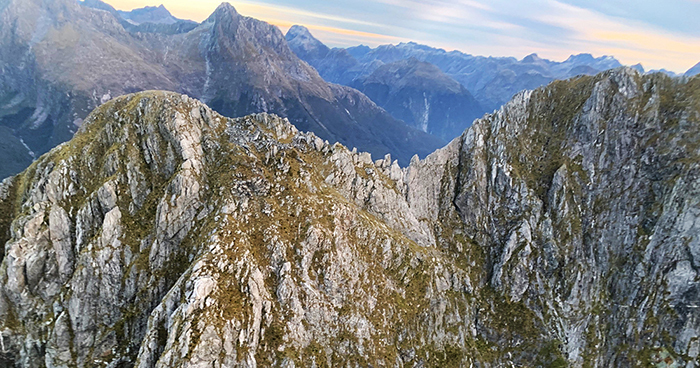
The Devil's Armchair, the 1627-metre peak that Hamish Attenborough set out to climb.
Shortly after midnight on Monday 28 March, Noel Saxon, Hamish’s boss at Ultimate Hikes, called Police. Hamish was overdue and he had not been able to contact him by radio.
Comms contacted the on-call Police SAR coordinator, Sergeant Ian Martin at Invercargill. Ian ascertained from the Rescue Coordination Centre (RCCNZ) that no activation from a PLB had been received.
Despite the lateness of the hour, Ian was able to organise an immediate response. He contacted the Milford Emergency Response Team (FENZ) and two members headed to Sandfly Point by boat. At around 2am, they found the kayak and paddle.
A helicopter from Southern Lakes Helicopters, conducting a medivac in the Milford area, flew in. The pilot – local SAR stalwart Sir Richard Hayes – used night-vision goggles as he followed Hamish’s proposed route, looking for a light source which might indicate his location. No light source was seen.
Ian called up Land Search and Rescue (LandSAR) teams to prepare to deploy at daybreak, and a search base was set up at Milford Sound Fire Station.
In the morning Sergeant Tod Hollebon, OC Te Anau and a SAR veteran with 20-plus years’ experience, headed to Milford to take the role of incident controller.
“It’s important to stress that we always search on the basis that we’re going to try to locate the person alive and never give up hope of that,” says Tod.
“We were well aware of what we were dealing with, what the possibilities were, but we always carry out searches in the hope of finding the missing person alive.
“We’ve had situations in the past where - even after several days - we’ve had some incredible results. But we’re always also realistic about what we’re dealing with.”

A briefing for the team.
The search was conducted by air and land, day and night.
The aerial search followed Hamish’s proposed route and possible alternatives, with trained air observers using night vision and thermal imaging equipment as necessary to reduce the size of the area where Hamish might be.
On the ground teams of LandSAR volunteers and Police SAR members undertook a coordinated search, aided by good weather in an area where sudden changes are nothing unusual. Safety of all the search teams was a top priority.
“The weather was very kind to us,” says Tod. “We were lucky - it was nice and clear throughout, which isn’t always the case. The water courses were flowing at their lowest levels for a long time.”
Highly skilled trackers and a SAR dog followed the ridge to the peak, finding signs that Hamish had been there.
High on the Devil’s Armchair there were fresh boot prints heading up to the peak and down again.
Scratches showed where a boot had scuffed a stone against a larger rock. There was dislodged moss – tiny clues of huge significance, which disappeared on the way down the ridge, below the bush line.

The way in for people and gear was at the end of a 125-metre line.
The steepness of the slopes dropping from the ridge called for specialist skills. Alpine Cliff Rescue (ACR) teams roped up to scour the faces. They are more used to searching bare slopes, but they painstakingly looked for clues in the dense and otherwise inaccessible bush.
From the search base, inquiries were building a picture of Hamish’s climb. People who had previously climbed the Devil’s Armchair provided their routes up and down, identifying the most difficult and dangerous sections and places where a climber might go off course.
Helicopters continued the aerial search. On the morning of Tuesday 29 March, Southern Lakes helicopter pilot Snow Mullally picked up a weak radio signal on frequency 121.5, which seemed to be the secondary signal from a PLB.
It lasted only a short time but gave an area of interest for further searching - a steep and barely accessible gorge above the Giant Gate Falls.
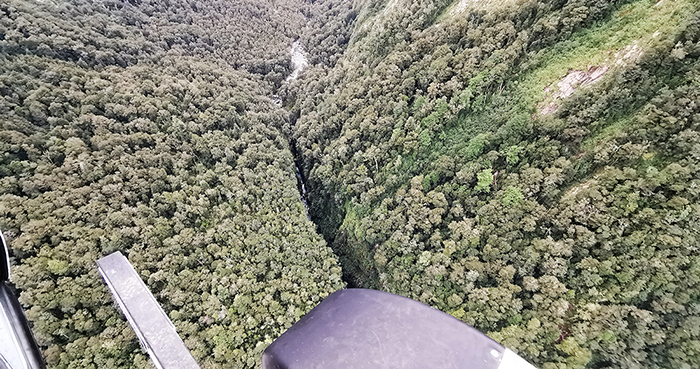
A weak PLB secondary signal identified a remote and inhospitable gorge as a location of interest.
The gorge is not for the faint-hearted. It is on no-one’s holiday itinerary – it doesn’t even have a name.
It is wildly beautiful but almost impenetrable; extremely deep and extremely narrow in parts, strewn with huge boulders. There are treacherous waterfalls, rapids and very deep pools. The water is clear and very cold.
Navigating it is a job for specialists and Tod's team knew who to call. On the Tuesday afternoon a four-strong volunteer canyoning team from Queenstown and Wanaka, led by veteran Roy Bailey, arrived in Milford.
Among the members was one of the few people to have been through the canyon but it was decided it was too late in the day to go in.
The following morning, on Wednesday 30 March, the team was lowered in by helicopter on a 125-metre line.
They made their way carefully down the gorge, probing and searching any area where a body might be concealed. After around 300 metres they spotted a blue T-shirt in a pool below a waterfall.
They explored the pool and found what appeared to be a submerged body, snagged in rocks metres below the surface. Elsewhere in the pool they found a black bag, also wedged in rocks below the surface.
Now it was time for another team of specialists to take over.

A place of wild beauty and countless dangers.
Invercargill SAR member Detective Dougall Henderson contacted the Police National Dive Squad (PNDS) at Seaview, Wellington, at around 11am on Wednesday 30 March.
PNDS OC Senior Sergeant Bruce Adams and team member Detective Ben Pye were approved to deploy – but even getting to the scene was a 24-hour challenge in itself.
Wellington was fogbound and there were no flights south from Palmerston North. They considered driving to Hamilton or Auckland to catch a flight but in the end room was found for them and their gear on an Interislander freight sailing.
After a drive from Picton to Christchurch, a commercial flight to Queenstown and then a helicopter flight, they arrived in Milford around midday on Thursday 31 March.
They were met by Ian Martin, were briefed and met the local search team. There were familiar faces. “The helicopter pilots are fantastic," says Bruce. "We’ve worked with them before on jobs. You’ve got to respect the other experts in a situation like this.”

The 300-metre journey was full of hazards - including massive slippery boulders requiring abseil skills...
With the canyoning team in the lead, they and their gear were lifted by helicopter on the 125-metre lines and lowered into the gorge. The nearest spot where they could be landed safely was around 90 minutes’ slog upstream of the pool.
They were carrying river sets - compact dive gear - because of the narrowness of the gorge. They wore stout field boots provided by Capability to get them over the rocks. “In our normal footwear it would have ripped our toenails off.”
The way in for people and gear was at the end of a 125-metre line.
“The gorge was certainly a challenge,” says Bruce. “Walls 100 metres high, slippery rocks, narrow and dark. The water temperature was no more than 5C.
“Abseiling is part of our training but without the canyon team we just couldn’t have done it without injury. They were fantastic.”
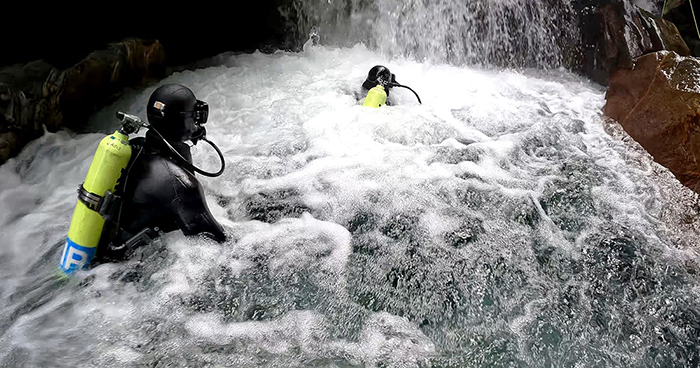
Like being in a washing machine - Senior Sergeant Bruce Adams and team member Detective Ben Pye search the pool.
They searched for any items of interest as they went. They arrived at the pool around 3.30pm and the canyoning team showed them where they had found Hamish and his gear.
They found Hamish was wedged by his left leg between rocks about 1.8 metres below the surface. It took around 30 minutes for Bruce and Ben to free him, taking turns to work in the turmoil beneath the waterfall.
“It was like being in a washing machine,” says Bruce. “It was 30 minutes of pounding from the waterfall.”
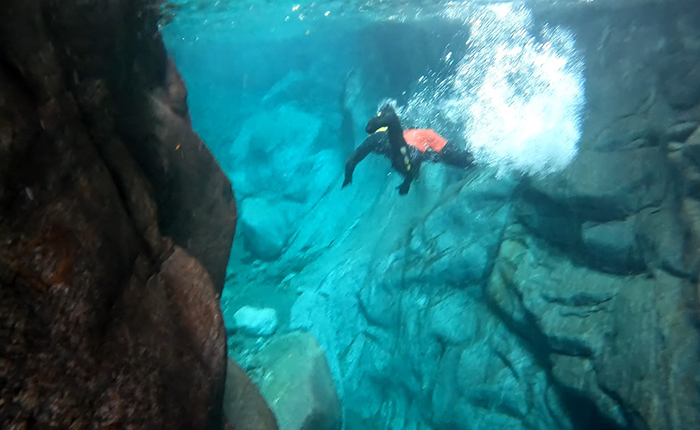
Water in the deep, cold pools was no more than 5C.
When Hamish was freed, they secured him in a recovery stretcher and the helicopter lifted him carefully out of the narrow gorge, carrying him toward waiting DVI staff on the first stage of his journey home. It was 5.09pm.
Bruce and Ben searched the pool for evidence but found nothing more. For them and the canyoners, it was another 90 minutes’ slog down river to where the canyon opened up enough for them to be lifted safely out.
The divers returned to Wellington the following day.
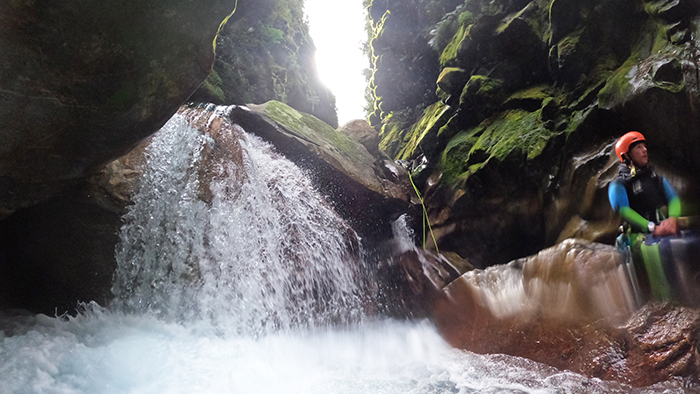
Journey's end - the pool where Hamish was found.
It is unlikely the exact nature of the disaster which befell Hamish will be known, though the investigation found nothing to suggest it was anything other than a terrible accident.
He may have fallen into the gorge while descending from the mountain, having deviated from the accepted route, or may have already been in the gorge, lost his footing on the treacherous boulders and fallen into the pool where he was trapped.
For the Police SAR team, the divers and the volunteer searchers, it was an exceptionally challenging operation. While it was clear from early on that it was very unlikely Hamish could be saved, there was satisfaction in being able to return him to his grieving family.
“At the end of the day, we were able to get Hamish home,” says Bruce. “While it wasn’t the outcome anyone wanted, there is satisfaction in knowing we helped achieve that.”
Despite the tragic outcome, says Dougall Henderson, the search and recovery were an amazing team effort.
“Obviously this is a tragic and sad result, and we weren’t able to control what happened to Hamish, but we were able to control an operation to return him to his family very swiftly,” says Dougall.
“I’ve been involved in a lot of searches - to make this find, in this terrain, in just three days is an amazing team effort and a testament to how we all worked together with our partner organisations. Everyone involved pulled together.”
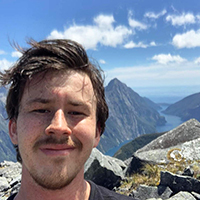
This story is dedicated to the memory of Hamish Attenborough, and to all those who worked to bring him home.
Published by permission.
Ten One Magazine
NEWS



